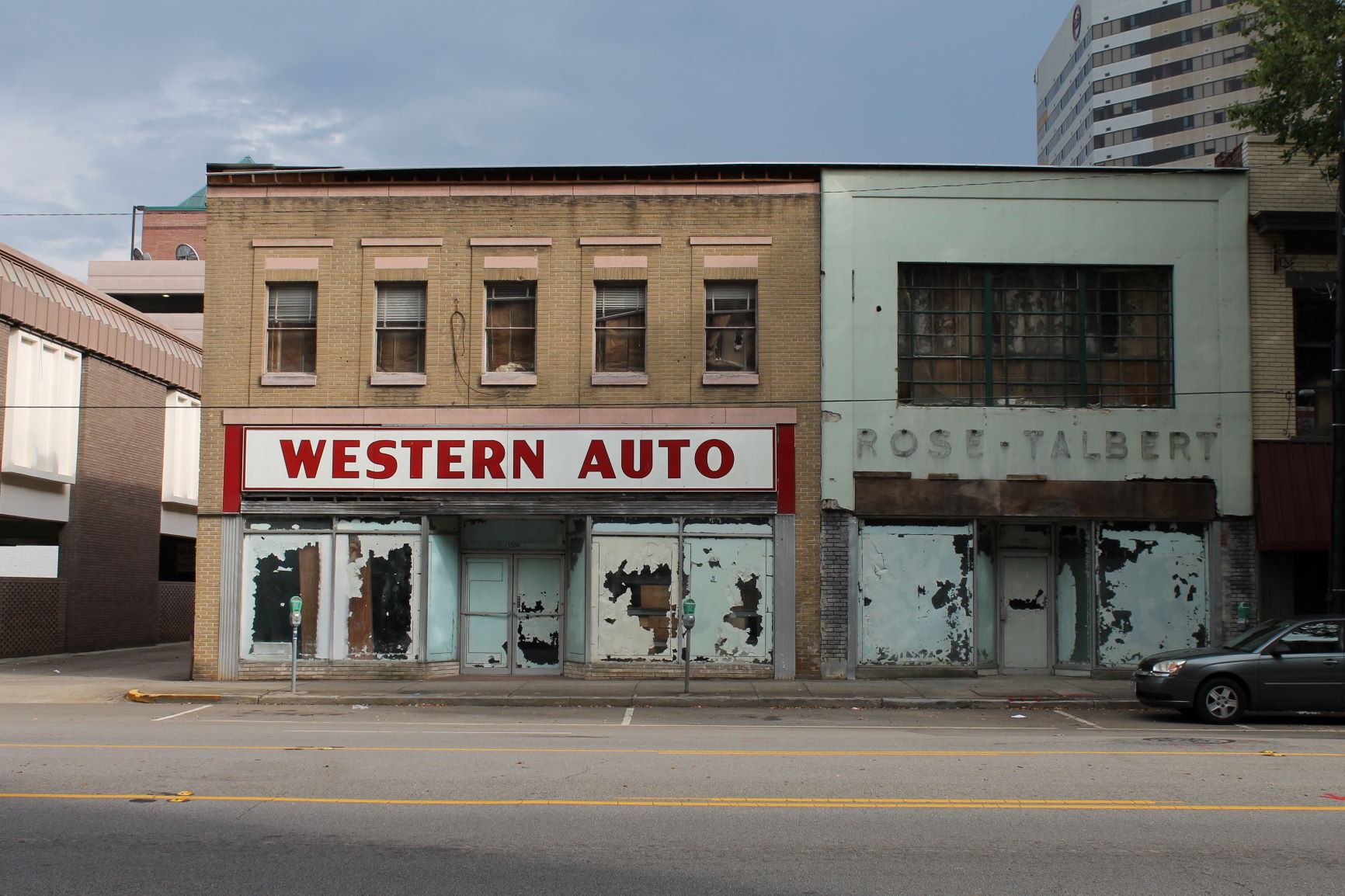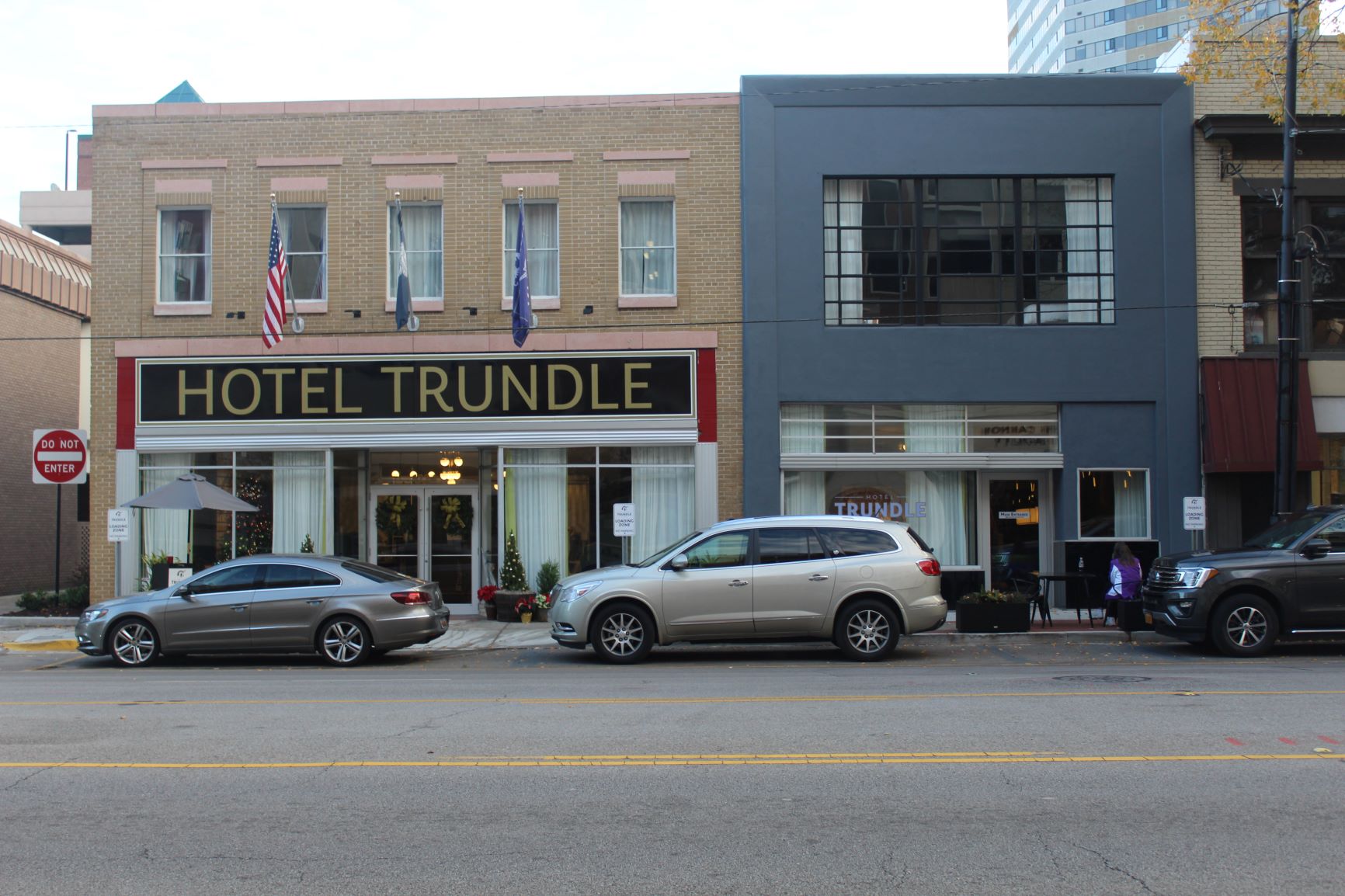The following article is first in a series explaining how to use economic development tools.
The SC Abandoned Buildings Revitalization Act, first effective on January 1, 2013, and later extended by the General Assembly through 2021, offers income or property tax credits as a way to promote the rehabilitation of eligible empty or underutilized buildings. The taxpayer who rehabilitates an eligible building may apply for one of the tax credits, and the credit may be passed through to tenants or subsequent purchasers of the property.

The Western Auto building (1940) and Rose-Talbert building (1914) in downtown Columbia stood vacant before they were renovated together in 2018. Photo: Rogers Lewis.

The new space for Hotel Trundle and the BOUDREAUX design firm made use of incentives
including the Abandoned Buildings Revitalization Act, the Bailey Bill, tax credits and façade easements. Photo: Rogers Lewis.
Combining the abandoned building credit with state and federal historic rehabilitation credits can dramatically increase the total tax credit available. A taxpayer could have a potential total credit equal to 55 percent of qualified rehabilitation expenses — 20 percent federal historic preservation, 10 percent state historic preservation and 25 percent abandoned building credit.
Meeting eligibility requirements
At the time the taxpayer files the Notice of Intent to Rehabilitate, the property must be
- at least 66 percent vacant for the past five years, and the taxpayer who owned the building immediately before its abandonment is not eligible to claim a credit;
- non-income-generating throughout the abandonment; and
- something other than be a single-family residence.
Buildings placed into service after July 1, 2018, can be divided up by floor so that up to seven separate floors can be considered seven separate projects eligible for the credit. However, to be eligible for the credit, the floors must be redeveloped exclusively for residential use.
The tax credit requires that the developer spend a minimum amount of money rehabilitating the property, whether it be through the cost of acquiring the property, renovating or improving the site, or cleaning up environmental hazards. Demolition costs cannot be considered an eligible expense in cases where the building is on the National Register of Historic Places.
The minimum investment in an eligible project is lower in small communities because of the greater difficulty of attracting investment in rural areas. The minimums are determined by the population of either the municipality or the unincorporated area of a county where the project is located:
- more than 25,000 people: $250,000
- between 1,000 and 25,000 people: $150,000
- less than 1,000 people: $75,000
Tax credit options and amounts
A taxpayer may choose one of two credits:
- Income tax credit: This credit can equal up to 25 percent of eligible rehabilitation expenses taken against state taxes and fees — income tax, the corporate license fee, taxes on associations or a combination of these — but the credit cannot exceed $500,000 in any tax year. The taxpayer must submit the Notice of Intent to Rehabilitate to the SC Department of Revenue. If a project receives approval for an income tax credit, then the taxpayer receives the credit in equal installments over five years, beginning with the tax year the property enters service.
- Property tax credit: The property tax credit may equal up to 25 percent of the total rehabilitation expenses, but no more than 75 percent of the real property taxes due on the building. In this case, the Notice of Intent to Rehabilitate must be submitted to the relevant municipality or county. An approved project can receive a property tax credit for as many as eight years, beginning with the tax year the building enters service.
The application process
The Notice of Intent to Rehabilitate must provide the site's location, the amount of acreage involved, the square footage of the existing buildings on the site and the estimated expenses for rehabilitation. The notice must also indicate which buildings the taxpayer intends to renovate and whether new construction is involved. In addition, when the notice is filed, the "local taxing entity ratio" must be set and remain fixed for the credit period. The local taxing entity ratio is the millage rate of each participating local taxing entity divided by the total combined millage rate of all participating taxing entities.
When seeking a property tax credit from a municipality or county, the governing body must determine and certify the eligibility and proposed rehabilitation expenses by a resolution approved by a positive majority vote. This determination must include a finding that the credit will not violate any covenant, representation or warranty in an existing tax increment financing district.
The council must then hold a public hearing and approve the tax credit by adopting an ordinance. At least 45 days before holding the public hearing, the governing body must give notice to all affected local taxing entities its intention to grant the property tax credit. This notice must include the estimated credit based on projected rehabilitation expenses. If the other local taxing entities do not file an objection, they are deemed to have consented to the credit.
